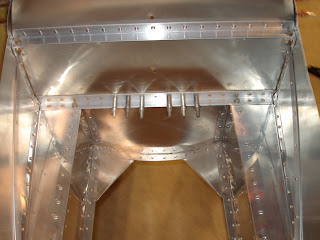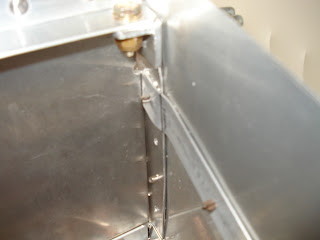Rudder 1


This blog was created to chronicle the building of two Hummel Ultracruiser ultralights.


Posted by
Charles S
at
4:20 PM
0
comments
![]()
Labels: rudder

 The tailcone model or which end is this?
The tailcone model or which end is this?
Posted by
Charles S
at
8:51 AM
0
comments
![]()
Labels: tailcone
Posted by
Charles S
at
9:41 PM
0
comments
![]()
Labels: elevators

Posted by
Charles S
at
9:19 PM
0
comments
![]()

Posted by
Charles S
at
2:09 PM
0
comments
![]()
Labels: horizontal stab

 Here are five items to watch for when constructing the tail -
Here are five items to watch for when constructing the tail -
Posted by
Charles S
at
8:14 AM
0
comments
![]()
Labels: horizontal stab, notes
Posted by
Charles S
at
9:22 PM
0
comments
![]()
Labels: horizontal stab
Build hours: 286
Well, a quick post about stab skins. After installing a stab skin, your are qualified to be a one-armed wallpaper hanger. We have not actually completed a skin yet but here's a quick clip on vacuum forming.
Posted by
Charles S
at
8:33 AM
0
comments
![]()
Labels: horizontal stab


Posted by
Charles S
at
11:30 PM
0
comments
![]()
Labels: horizontal stab, notes


Posted by
Charles S
at
10:55 AM
0
comments
![]()
Labels: notes, vertical stab
 Top rib installed.
Top rib installed. Here the skin is clecoed into position for the final riveting. The skin was vacuum formed instead of "carpet formed" as described by Bill Spring and Morry. We hated to break tradition but after seeing the Sonex guys form their wing leading edges on YouTube?? we had to try it. A short video clip will be added later when the horizontal stab skins are made but we had so much fun forming the vertical stab skins that we couldn't stop:)!
Here the skin is clecoed into position for the final riveting. The skin was vacuum formed instead of "carpet formed" as described by Bill Spring and Morry. We hated to break tradition but after seeing the Sonex guys form their wing leading edges on YouTube?? we had to try it. A short video clip will be added later when the horizontal stab skins are made but we had so much fun forming the vertical stab skins that we couldn't stop:)!  And here is the final product. The top rib has not been riveted so that the refuge from installation of the dorsal fin (coming next) can be dumped.
And here is the final product. The top rib has not been riveted so that the refuge from installation of the dorsal fin (coming next) can be dumped.
Posted by
Charles S
at
7:30 AM
0
comments
![]()
Labels: notes
 Many of the empennage parts had been precut in between other building task and were ready for forming. The obligatory particle board form blocks were cut, smoothed, rounded, etc and the rib were carefully formed. Of course, with the curved flanges, the parts came out of the forms with ripples in the flanges and curved like a banana :( It was finally time to use the shrinker. A few soft presses straightened the part and we drilled and clecoed the ribs to UCA and UCB.
Many of the empennage parts had been precut in between other building task and were ready for forming. The obligatory particle board form blocks were cut, smoothed, rounded, etc and the rib were carefully formed. Of course, with the curved flanges, the parts came out of the forms with ripples in the flanges and curved like a banana :( It was finally time to use the shrinker. A few soft presses straightened the part and we drilled and clecoed the ribs to UCA and UCB.
Posted by
Charles S
at
7:10 AM
0
comments
![]()

Posted by
Charles S
at
7:09 AM
0
comments
![]()
Both engine compartments are riveted up and ready for the engine cover. The lower engine baffle and braces are under the skin for a smoother look. The nose cowl hole and slot is flanged and the engine cover will lay flush on the nose cowl ledge. The nose cowl will not be riveted until the engine can be test fit and the oil cooler baffle can be installed. Plan note:Our next step is to flush rivet every other hole on the side rails back to bulkhead "B" and add the angles to the bottom of the fuselage before retiring to some tail work!
Plan note:
We intended to flush rivet every other rivet on the siderails between bulkhead "A" and "B" per the plans. The plans do not mention the need to countersink the rail holes so that the skin can be dimpled for the flush rivets which would need to be done before installing the rail! (The catchall plan note is - prior building experience is required!) With only the rivets in the C to D skin needing removal, we could have accomplished the countersinking. However, a call to the factory suggested using the universal head rivets and then relieving the tank cover skin for those rivets. This is simpler and allows the entire rail to have a 1" rivet pattern showing.



Posted by
Charles S
at
2:37 PM
0
comments
![]()
Labels: notes

Posted by
Charles S
at
7:47 PM
0
comments
![]()
Labels: engine compartment

Posted by
Charles S
at
7:32 PM
0
comments
![]()
 A joggle was added at the upper end to stop the skin from being pulled in at the firewall.
A joggle was added at the upper end to stop the skin from being pulled in at the firewall. 

Posted by
Charles S
at
7:14 PM
0
comments
![]()
Posted by
Charles S
at
1:26 PM
0
comments
![]()
Labels: engine compartment

Posted by
Charles S
at
9:36 AM
0
comments
![]()
Labels: engine compartment, skins
 Anyhow, we riveted the top angle to bulkhead "A". Riveted the engine supports together and to the lower angle on "A" but did not rivet the lower angle to "A". We're planning to align, drill and rivet the engine skins before riveting the lower angle and supports to "A" so that blind rivets are not needed below the engine mount at the "A" bulkhead. This also means we have to order the nuts and bolts that become inaccessible after closure. Two additional changes are also being considered, see below. Installed the engine nutplates and mounted a plywood engine pattern to hold the mount square while fitting the skins.
Anyhow, we riveted the top angle to bulkhead "A". Riveted the engine supports together and to the lower angle on "A" but did not rivet the lower angle to "A". We're planning to align, drill and rivet the engine skins before riveting the lower angle and supports to "A" so that blind rivets are not needed below the engine mount at the "A" bulkhead. This also means we have to order the nuts and bolts that become inaccessible after closure. Two additional changes are also being considered, see below. Installed the engine nutplates and mounted a plywood engine pattern to hold the mount square while fitting the skins.

Change 1 - Make the filler plates in two pieces. One piece rivets to the skin, the other rivets to the vertical engine support then the two pieces are riveted together when adding the engine ring.
Follow up: Decided to stick with the plan filler pieces and use blind rivets as needed.
Change 2 - Speaking of the engine ring... After looking at various examples of the engine ring implementation, we decided to purchase a real metal shrinker(Porto-Metal, I believe) and shrink the flange around the top of the ring. We needed the shrinker for the ribs anyhow to avoid fluting so why not!
Follow up: Fluting and hand skrinking aluminum in the T6 state is only practical for large radii and the metal shrinker must be used sparingly to avoid marking the material to much!
Posted by
Charles S
at
1:20 PM
0
comments
![]()
Labels: engine compartment, skins
When Rick and I got back together we were able to drill and cleco the engine mounts together and hang them on the firewall. The mounts were squared by clamping a wood spreader to the front and an engine compartment skin pattern was made. The engine mounts will be leveled when the skin is attached. Finally, all holes EXCEPT the firewall holes that hold the rudder bar attachment were drilled to 1/8".


Posted by
Charles S
at
12:43 PM
0
comments
![]()
Labels: engine compartment, metal shrinking

Posted by
Charles S
at
1:43 PM
0
comments
![]()
Posted by
Charles S
at
9:38 PM
0
comments
![]()
Posted by
Charles S
at
9:36 PM
0
comments
![]()
Labels: skins
Posted by
Charles S
at
9:31 PM
0
comments
![]()
Posted by
Charles S
at
8:55 PM
0
comments
![]()